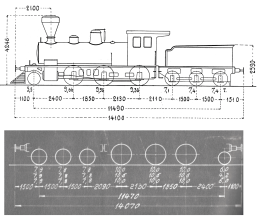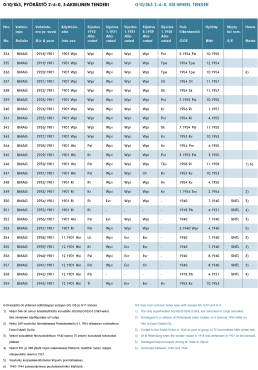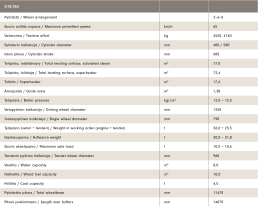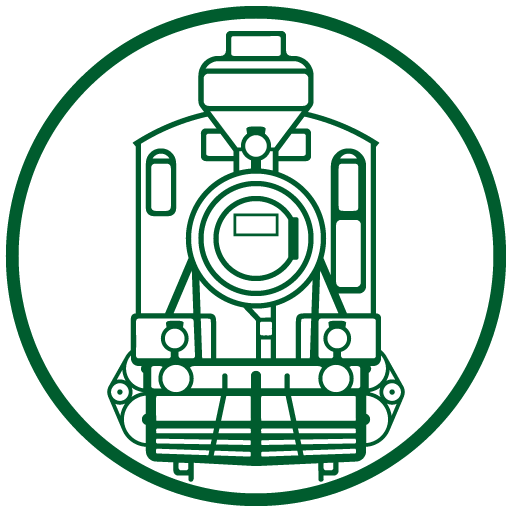Sk3 nro 342 juhlajunan veturina 21.3.1943 Aunuksenlinnassa. Rata Aunukseen on valmistunut. Veturin sarjamerkki oli edellisvuonna vaihtunut G10:stä Sk3:ksi.
G10 class no. 342, seen at the head of the inauguration train at Aunuksenlinna on 21 March 1943, to mark the completion of the Aunus line. The G10s had recently been reclassified Sk3.
SA-kuva / SA official army photograph
Heinäkuussa 1900 tilattiin saksalaiselta Schwartzkopffilta 26 veturia, jotka olivat G3-tyyppisiä. Ne valmistuivat keväällä 1901 saaden sarjamerkin G10 ja numerot 334–359. Tämä oli pitkään viimeisin SVR:n ulkomailta tekemä tilaus. Vuonna 1942 tehdyssä sarjamerkkiuudistuksessa jäljellä olleet G10:t yhdistettiin sarjojen G3, G5 ja G11 kanssa sarjaksi Sk3.
G10-veturit olivat yhdyskoneistoisia ja ne oli varustettu märkähöyrykattilalla. Niissä oli Stephensonin sisäpuoliset luistikoneistot ja tasoluistit. Vetureissa oli yksiakselinen johtoteli ja kolme vetoakselia. Tenderi oli kolmiakselinen.
Kaikki G10-veturit valmistuivat halkolämmitteisiksi. Myöhemmin ne olivat toistuvasti muutettuina hiililämmitteisiksi, usein edelleenkin halkosavutorvella varustettuina. Vetureissa oli kaasuvalaistus. Niissä aluksi ollut Winterthurin käynnistysventtiili korvattiin myöhemmin Dultzin käynnistys- ja vaihtoventtiilillä.
Veturi 346 varustettiin vuonna 1915 tulistinkattilalla, sen yhdyskoneisto muutettiin samalla kaksoiskoneistoksi ja tasoluistit korvattiin mäntäluisteilla. Sarjamerkki säilytettiin ennallaan, vaikka veturi erosikin huomattavasti sisarvetureistaan. Veturissa kokeiltiin turvepulverilämmitystä vuosina 1915–19. Kokeilujen jälkeen siihen sijoitettiin A7-veturin 230 kaksiakselinen tenderi. Turvepulverikokeilusta poikkeava turvelämmitys aloitettiin veturissa 335 vuonna 1943. Veturissa 339 kokeiltiin Kylälän lietsointa vuosina 1918–19. Viipurissa käytössä olleiden vetureiden 353–359 hytin ikkunoita suurennettiin.
G10-sarjaa käytettiin aluksi pääasiassa tavaraliikenteessä, myöhemmin jonkin verran myös seka- ja henkilöjunissa. K3–K5-veturit syrjäyttivät G10:t tavarajunista ja ne siirrettiin vähitellen järjestely- ja työjuniin sekä vaihtotyöhön.
Vetureista 334–359 kymmenen sijoitettiin Viipuriin, yksitoista Helsinkiin ja viisi Riihimäelle. Ne siirrettiin 1930-luvulla vähitellen pääosin Itä-Suomen varikoille, joskin niitä käytettiin vähäisiä aikoja muuallakin.
Suomessa olleilla saksalaisilla joukoilla oli vuonna 1918 käytössään veturit 191 (G5) ja 336 panssaroituina. Ne jäivät Suomen Puolustusvoimille saksalaisten joukkojen poistuttua maasta ja palautettiin takaisin Valtionrautateille vuonna 1921. G10-vetureista 351 ja 358 jäivät Venäjälle vuonna 1918 ja ne hylättiin poissaolevina vasta 1921. Numero 353 vaurioitui hylkäyskuntoon Viipurin pommituksissa vuonna 1940. Numerot 350, 352 ja 354–357 luovutettiin Neuvostoliittoon talvisodan jälkeen vuonna 1940. Jatkosodan aikana veturit 336 ja 346 palvelivat panssaroituina panssarijunissa tai niiden huoltojunissa. Numero 349 hylättiin yhteentörmäyksessä vaurioituneena vuonna 1954. Muut G10/Sk3:t-veturit hylättiin vuosina 1953–58.
In July 1900, the German company Schwartzkopff (BMAG) was awarded a contract for 26 G3 type heavy Moguls. The order was completed during the first half of 1901. The locomotives were classified G10 and numbered 334–359. For a long time, this was the last order placed abroad by either the SVR or VR. The technical differences were so minimal that classes G3, G5, G10 and G11 were amalgamated into the Sk3 class in the 1942 reclassification scheme.
The G10s were compound locomotives with a saturated steam boiler. They were equipped with Stephenson inside valve gear with slide valves. They had a one-axle leading truck and three driving axles. The tender had three axles. All the G10s were built as wood burners, later being repeatedly converted to coal-burners but still often keeping their spark arresting chimneys. Winterthur starting valves were initially fitted, but SVR began to replace these fairly soon with Dultz starting valves. The engines were equipped with carbide gas lighting.
No. 346 was in 1915 fitted with a new superheated boiler and converted from compound expansion with slide valves to simple expansion with piston valves. Although this rebuilding made it different to the sister engines, its classification was left unchanged in 1915 and later in 1942. This locomotive was used for the testing of pulverised peat as an alternative means of fuel between 1915 and 1919. No. 346 was coupled to the four-wheel tender of A7 class no. 230 after the peat testing period. Non-pulverised peat was later adopted as fuel in 1943 for no. 335 and several other locomotives of other classes.
A Kylälä single blast pipe was experimentally used on no. 339 between 1918 and 1919. Larger cab windows were fitted to nos. 353–359 whilst allocated to Viipuri.
Originally the G10s were intended for freight duties but later even worked mixeds and passengers. Classes K3, K4 and K5 subsequently replaced them on their regular goods rosters and they were later employed on permanent way and shunting duties until the latter half of the 1950s.
Nos. 334–359 were at first allocated to Viipuri (10), Helsinki (11) and Riihimäki (5). In the 1930s most of the class was gradually transferred into eastern Finland with short spells in other parts of the country.
Armoured-plated nos. 336 and (G5) 191 were used by German troops in 1918 and then the Finnish Army; these engines were returned to the SVR in 1921. G10s nos. 351 and 358 remained on Russian territory in 1918 and were withdrawn as being abroad in 1921. No. 353 was wrecked in an air raid at Viipuri in 1940. Nos. 350, 352 and 354–357 were surrendered to the Soviet Union after the cessation of the Winter War in 1940. Armour-plated Nos. 336 and 346 hauled artillery trains during the Continuation War. No. 349 was withdrawn after a collision in 1954 and the others in 1953–58.









